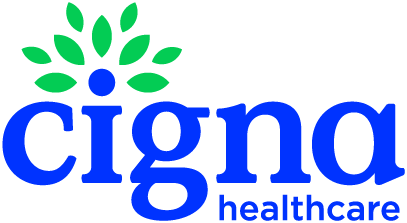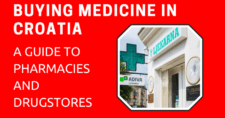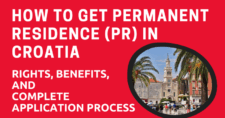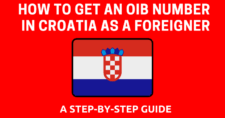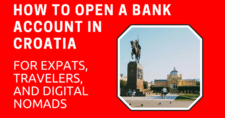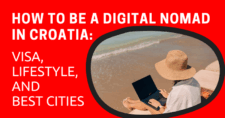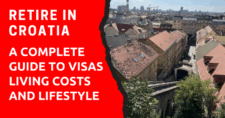
Planning to move to Croatia? This guide reviews the cost of living based on real experiences, including rent, food, transportation, health insurance, and money-saving tips you should know before settling down for the long haul in Croatia.
If you are looking for a country to live in comfortably amidst tranquil nature, Croatia might be a choice you haven’t considered before, but it’s worth opening your mind to.
When I first moved to Croatia, I was shocked by the vast difference in cost of living between summer and winter, especially the rent in tourist cities like Split or Dubrovnik. In summer, the prices skyrocket because the towns are bursting with tourists (and landlords don’t care much about their tenants). But come winter, rents drop to two to three times less.
In this guide, I’ll share firsthand experiences of life in Croatia, from rent, food, utilities, water, and internet to those little things people often overlook but significantly impact daily life. I hope my experiences give you a clearer picture and make it easier for you to decide if you’re considering moving to Croatia.
This article will take approximately 28 minutes to read. Don't have the time right now? No worries. Email the ad-free version of the article to yourself and read it later!
Disclaimer: This article may include links to products or services offered by ExpatDen's partners, which give us commissions when you click on them. Although this may influence how they appear in the text, we only recommend solutions that we would use in your situation. Read more in our Advertising Disclosure.
Contents
- Key Takeaways
- Understand the Difference Between Summer and Winter Expenses
- How Much Does Accommodation in Croatia Cost?
- What Utilities Are There in Croatia?
- How Much Does Transportation in Croatia Cost?
- How Much Are the Monthly Living Expenses in Croatia?
- Family Costs
- Healthcare Costs and Health Insurance
- Visa Fees and Residency Status
- Tax Registration and Legal Requirements
- Average Costs in Various Cities of Croatia
- Overall Expenses Summary
Key Takeaways
- The cost of living in Croatia varies greatly between summer and winter, especially rent.
- Average utilities cost €20 to €30 per person per month.
- Home internet costs around €34 on average, while a mobile plan with 10GB is about €10.
- Public transport is cheaper if tickets are bought in advance, with average fares of €1.25 to €3.50.
- Uber and Bolt are convenient in many cities, with fares starting at €15.
- Car rental costs €250 to €1,000 per month, depending on the season and car size.
- Groceries from supermarkets are much cheaper than local markets.
- Cooking at home is much more economical, averaging only around €200 to €400 per month.
- The cost of living in coastal cities is higher than in smaller cities like Osijek or Rijeka.
- Monthly budget required:
- With a budget of €800 to €1,200, you can live simply in smaller towns.
- With a budget of €1,500 to €2,500, you can live comfortably in major cities without being too frugal.
- With a budget of €3,000 or more, you can live comfortably even in premium tourist destinations.
Understand the Difference Between Summer and Winter Expenses
Croatia is a favorite holiday spot for Europeans. Therefore, the important thing about living in Croatia is which season you choose to stay. If you relocate in the summer, costs can be five times higher compared to winter. So, to give you a clearer picture and to help plan your finances appropriately, I will delve into and share experiences of living in Croatia.
How Much Does Accommodation in Croatia Cost?
According to the Croatian Bureau of Statistics, the cost of accommodation in Croatia varies by the popularity of the city. Especially in popular coastal cities like Dubrovnik or Split, prices can be much higher compared to others.
It’s important to note that if you’re looking for a home in Croatia during summer, you might struggle to find something nice. Therefore, I recommend starting your house hunt at least one to three months in advance. The closer you get to the peak season, the more expensive it will likely be.
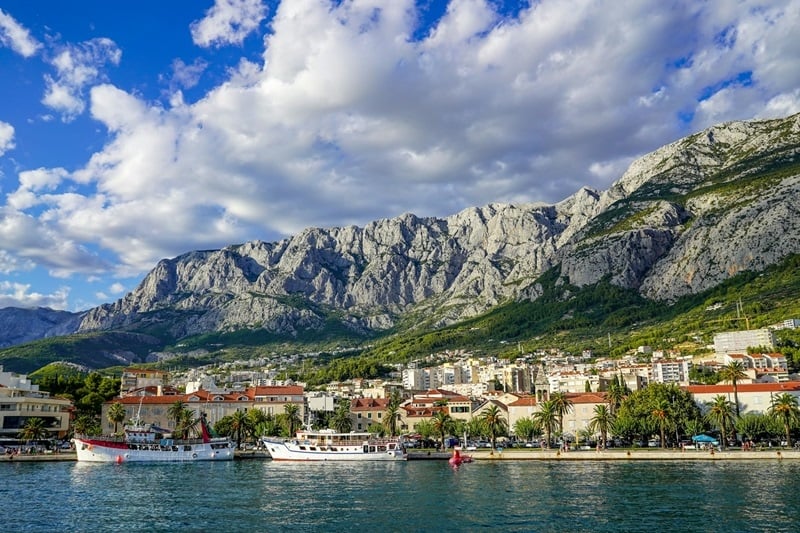
During my time living in Split in 2024, it was just after Croatia joined the Schengen Area, which made Croatia even more popular. I traveled there in June, which is the start of summer, and many accommodation places were fully booked. However, by preparing three months in advance, I managed to get a one-bedroom, one-bathroom apartment near the airport for only €500, including utilities. It came with a kitchen, water heater, washing machine, and air conditioning. Although it didn’t have Wi-Fi, it was comfortable enough for up to three people.
Even though I was lucky enough to get my first apartment quickly, finding long-term accommodation in Croatia is an issue many people face. But this is normal here. My first apartment lease was for two months, so now I have to find a new place.
A Croatian friend recommended I try finding a new place to stay on Njuškalo, a popular app specifically for renting accommodation in Croatia. The benefit is there are lots of options and the prices are much better than elsewhere, and I was fortunate to find a new apartment in the summer, which is usually the hardest time to find a place. The best part, I got it for only €900.
This apartment is a decent size with two bedrooms, one bathroom, and one kitchen, fully furnished. However, this price doesn’t include utilities like electricity, water, internet, and waste disposal fees.
The two apartments I stayed at over the summer were reasonable in terms of price, location, size, and condition. Although they weren’t luxurious and were a bit far from the city, they were well-equipped and sufficient for living.
When comparing with my expat friend who’s a digital nomad living in Split and the old town of Trogir, I feel incredibly lucky. My friend mentioned that the apartment they rent for two people is a tiny room above a restaurant, which means it’s noisy all night. But what’s more shocking is the rent is as high as €3,000 per month, and the place is quite old since it’s in a conservation area. Sometimes the air conditioner doesn’t cool well, or worse, there’s no running water at all. This is a common issue in the old town. However, it’s convenient for traveling and has a lot of restaurants.
Accommodations in Croatia are pricey in the summer, but during the winter months (October to March), you can find a luxurious city-center apartment for €500 with all modern amenities.
Or, if you step outside the city, it’s around €200. If you’re traveling with family or friends and want a fancy villa with a pool, you can rent it for €1,000 to €3,000. It’s clear that the season you visit significantly affects accommodation costs in Croatia.
What Utilities Are There in Croatia?
From my experience, the monthly costs for electricity, water, and garbage disposal are about €20 to €30 per person. This is reasonable, especially during the hot summer months when I tend to use the air conditioner a lot more. This might cause the electricity bill to go up a bit.
In Croatia, internet costs are similar across different networks. Home internet with a speed of 60 Mbps costs around €34.45 per month. For mobile internet, I opted for a 10GB package from A1 which costs about €9.99 per month.
Typically, the cost of cable TV in Croatia is bundled with home internet packages, so you don’t have to pay separately. However, most channels are in the local language, and a lot of the shows are about football and history. If you’re like me and love watching movies or series, I’d suggest subscribing to an additional streaming service. I’ve chosen Netflix, which costs about €9 per month, and that’s enough for my needs.
How Much Does Transportation in Croatia Cost?
The public transportation system in Croatia might not cover every area, but each city has its own public transport services. A common feature that can save you considerable money is buying tickets in advance through apps or various shops, which are cheaper than buying directly from drivers.

Public Transportation Costs
Public transportation in Croatian cities is regulated by local transport authorities and the Ministry of Transport. Zagreb’s ZET, Split’s Promet Split, and other municipal transport companies set official fares that are subject to government approval.
That said, living in Split, there’s only one direct bus route from Split to Kastela to Trogir. However, buses, which are regulated by the Croatian Agency for Transport and Infrastructure, run every half hour. The fare, if bought in advance, is €1.25 per ride, and you can get on and off anytime within 90 minutes. If you buy a ticket from the bus driver, it’ll be €3.50 per ride. If you’re in the capital city of Zagreb, trams and buses cover the entire city. The fare depends on the travel duration, ranging from about €0.50 to €2, depending on the duration you choose to use the service.
For traveling to nearby cities, you can take private buses like Flixbus, Arriva Croatia, and many others. Prices vary based on distance. When I traveled to Dubrovnik, it took about four to five hours using Flixbus for €35 round trip. Traveling to Zagreb takes about five to six hours with a fare of €45, which is reasonable.
Taxi Costs
For ride-sharing, you can use Uber or Bolt. The prices are reasonable compared to other cities. Normally, I take Uber to the Mall of Split because it’s a bit inconvenient with multiple bus transfers and still not reaching the destination. The fare is around €15 to €20.
If you use a standard taxi, make sure it displays the official licensing and rate cards as required by local authorities.
If you want to have your own personal car, it’s a great option because there aren’t many cars on the road, there’s no traffic, and the roads are in good condition. Even if you’re not very experienced with driving, you’ll find it manageable.
Car Rental Costs
Regarding expenses, if you rent a small car, it’ll cost around €250 to €400 per month, which is reasonable. However, keep in mind that during the summer, the price can skyrocket to €600 to €1,000 per month, not unlike housing costs.
Buying a Car
If you’re thinking about buying a car in Croatia, it’s not that complicated. For a brand-new car, prices start at around €15,000. But if you’re budget-conscious and don’t mind whether it’s new or used, there are good second-hand options starting at just €2,000.
A Croatian friend told me that he got an old second-hand car for €1,500. It may be a bit old, but it still drives well and is sufficient for day-to-day use.
If you want a brand-new car and a better deal, here’s a tip from locals: they often choose to travel to neighboring countries like Slovenia or Hungary to buy new cars. The cost of living and car prices there tend to be lower. You can be sure you’ll get a better bargain on a new vehicle.
Fuel prices in Croatia, like everywhere else in the world, depend mainly on global market prices.
For me, I usually rely on buses for my daily commute, but sometimes I have to drive my own car. My average fuel cost is around €30 to €50 per month.
I rarely drive my private car because parking in Split is very hard to find, especially near the marina and in the old town zone. You might have to pay €4 per hour or more for parking.
I’ve had firsthand experience with parking fees in Split. The first time I drove into the city and parked, I stayed for about six hours only, but it turned out I was charged up to €45. This happened because if you park for more than three hours, the system automatically charges you the daily rate, which is pricier than I expected.
If you’re really interested in buying a car, it’s important to note that Croatia requires car insurance, just like other European countries. Insurance costs depend on several factors such as the car model, year of manufacture, the driver’s driving history, and the type of coverage. On average, insurance costs around €25 to €50 per month.
How Much Are the Monthly Living Expenses in Croatia?
When thinking of buying personal items or fresh food, many might consider local markets for their affordability. However, in Croatia, it’s quite the opposite. In a city like Split, there are no typical local markets, only markets catering to tourists, which makes prices higher than usual.
Vegetables, Fruits, Meat
Personally, I find buying vegetables, fruits, or meat from supermarkets in Croatia more worthwhile. The prices are more stable, reliable, and you have plenty of choices with stores like Lidl, Spar, Konzum, Tommy, etc.
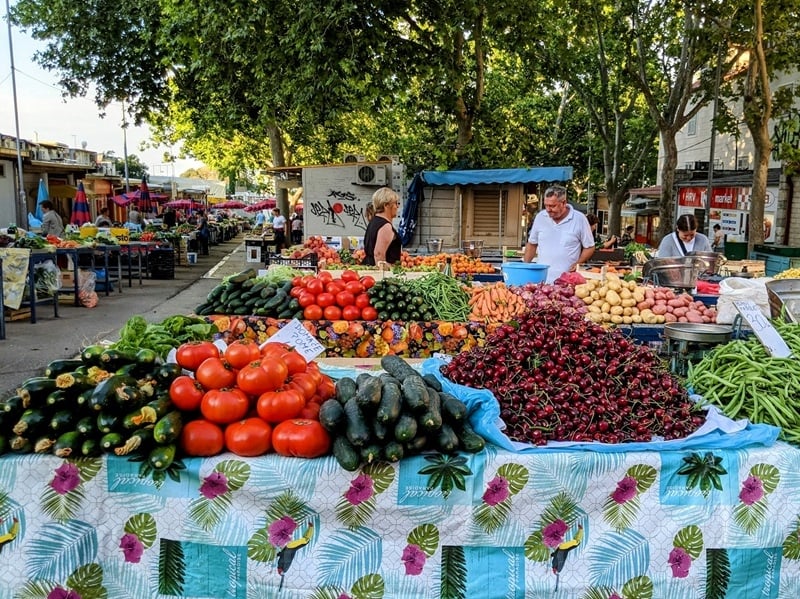
Here’s a simple example I’ve encountered:
- Half a kilo of strawberries at the local market is €8, but only €2 at the supermarket.
- One kilo of beef costs €30 at the local market, but only €10 at the supermarket.
- A single bottle of Coke costs €3 at the market, €6 at a restaurant, but only €0.90 at the supermarket.
When I first saw the prices, I was surprised. Initially, I planned to buy from local markets, but there are very few available here, and they’re much more expensive than supermarkets. If you’re staying long-term, buying groceries from supermarkets can save you substantial money.
If you want to save even more, I recommend Metro, a large wholesale store that stocks everything you need, from fresh produce to dry goods, and even Asian products. The prices are much cheaper than other supermarkets.
Important: Personal items like sunscreen or detergent are things you need to be cautious about, especially if you buy them in tourist areas where prices can be up to five times higher. For instance, if you plan to sunbathe on the beach but forget your sunscreen and end up buying it at a nearby supermarket, you might pay up to five times the normal price. Or take the hand cream I use regularly—it’s just €5 at my local supermarket, but in tourist zones, the price jumps to €6. Interestingly, in Austria it’s only €3, and in Germany, just €2.
Restaurants
For dining out in Split, you might find some lovely waterfront restaurants near the harbor, offering a selection of fine menus. For special occasions, you might want to try some excellent wine for €40 or a premium steak for the same price of €40. The ambiance and top-quality food make it worthwhile.
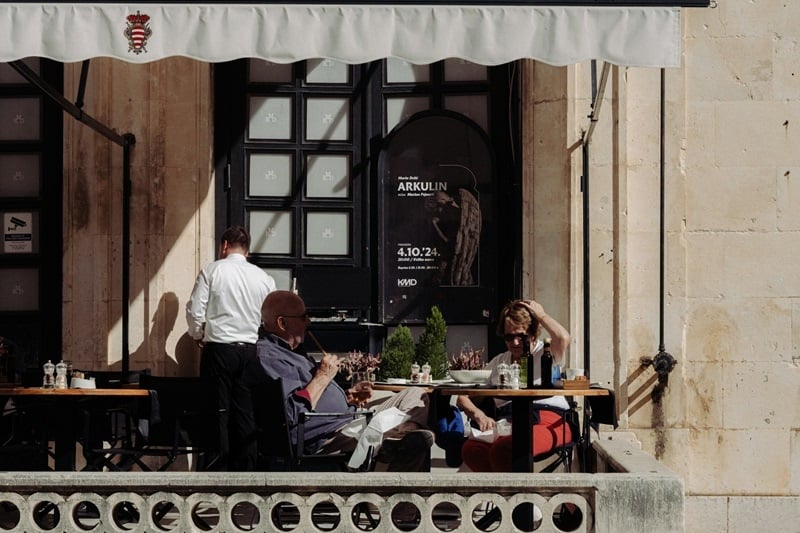
If you’re looking to save money, there are also fast food options available at more accessible prices, averaging around €10. For instance, you might find a delicious hamburger for €15 or crispy calamari for €10 per plate, which can help you stay within budget easily.
When I was living in Croatia, I cooked for myself almost every day because it was convenient, economical, and healthy. Most meals focus on fresh vegetables and simple meats like chicken breast, pork, or grilled fish. Making a meal costs about €5 to €7 and lasts for several servings, so it doesn’t feel like a strain on the budget at all.
I only eat out when I have errands in town or want a change of scenery on some days. Overall, my monthly food cost is about €200 to €400, which fits perfectly within my budget and allows me to maintain a good quality of life in Croatia.
Can You Drink Tap Water?
For locals who have lived here their whole lives, they might drink tap water just fine. But for tourists or expats, you can’t drink the tap water directly. If your home doesn’t have a water filter, you’ll end up drinking water that contains limestone. So, buying drinking water is your best option. Typically, a 1.25-litre bottle costs around €1.
How Much Do Leisure and Entertainment Activities Cost?
Croatia offers a wide variety of leisure activities. Whether you’re immersing yourself in the rich history of the old towns, enjoying a relaxing stroll around the city, or if you’re a sea lover, you can dive, island-hop, or just sunbathe all day.
For me, I usually spend my free time swimming at the beach near my home, which is free of charge because every beach in Croatia is public and not privately owned. However, there might be extra costs for renting a beach cushion and umbrella, around €10 to €20 per day. Renting snorkeling gear/kayak/SUP board starts at €15 to €50 per hour, or using the beachside outdoor shower costs about €1 to €3 per use, and you get around three to five minutes.
Exploring the old towns is free and won’t cost you a thing. However, some places might charge an entrance fee, like museums or historical sites, which is usually about €5 to €10 per location. Popular attractions can be a bit pricier, like the Dubrovnik Walls, costing around €35 per person. In Split, Diocletian’s Palace can be visited for free on the outside, but certain areas like the cathedral or basement have specific entry fees, ranging from €5 to €10 per point.
If you’re into entertainment and love watching movies, ticket prices are about €7 to €8.
For coffee lovers, Croatia has a wide array of coffee shops on nearly every corner. An espresso shot costs just about €1.50 to €2, and if you prefer a latte or cappuccino, it typically ranges from €2 to €3 (though it might be a bit higher in tourist areas).
I’m a coffee lover myself and I drink it every morning. If you’re into specialty coffee like me, buying beans to brew at home is the most cost-effective and satisfying option. Supermarkets or local stores offer a wide variety of coffee beans, from light to medium and dark roasts. Prices range from about €3 to €10 per 500 grams, depending on the type and origin. If you choose wisely, you might find beans from regions like Africa or South America at an affordable price, often tastier than what’s served at a café.
But if you’re the party type, most bars don’t have an entrance fee. Of course, you’ll need to order drinks, which usually cost around €15 to €20 per liter, while cocktails are about €10 per glass.
Family Costs
Croatia is considered a safe place for kids and it has many great schools. Especially in big cities like Zagreb and Split, there are international schools that accommodate foreign students and offer English-language curricula.
Tuition fees depend on the course and the school’s reputation. On average, primary school fees are about €8,500 to €18,000 per year, secondary school fees are approximately €9,400 to €20,000 per year, public universities cost around €800 to €4,000 per year, and private universities average €7,500 to €8,500 per year, which is cheaper compared to other Western European countries.
Healthcare Costs and Health Insurance
Croatia’s mandatory health insurance system is governed by the Croatian Health Insurance Fund (HZZO) under the Health Insurance Act.
According to HZZO regulations, anyone living in Croatia for more than three months must register for compulsory health insurance. The Croatian Ministry of Health oversees healthcare policies and regulations.
For current premium calculations and coverage details, expats should consult the official HZZO website and verify requirements with local HZZO offices, as regulations and costs change annually.
Typically, if you visit a doctor contracted with HZZO, the cost is €1.32 per visit. However, if you choose a private doctor without an HZZO contract, you might have to pay the full service fee, which is around €40 to €100, depending on the service. As for prescribed medications under the HZZO guidelines, you might not need to pay at all, but if you buy them on your own, you may have to cover the full amount.
If you want more details about the benefits and additional procedures, you can check out the HZZO website.
If you’re looking for more comprehensive coverage, having supplementary health insurance is an excellent option for expats. This type of insurance will cover the co-payment costs that are usually paid out of pocket when visiting a doctor, buying medication, or staying in a hospital. It relieves you from worrying about these minor expenses and also helps you access medical services more quickly.
Generally, the cost of this supplementary health insurance is around €10 to €40 per month, which is a worthwhile investment for peace of mind while living in Croatia.
I haven’t personally had direct experience with visiting doctors in Croatia, but a friend of mine had an accident. He had taken out an international insurance plan for €35 per month. The insurance covered all major expenses, including surgery fees, hospital stays, and room charges throughout his treatment period, which gave him peace of mind in emergencies.
Visa Fees and Residency Status
Visa and residency requirements in the country are governed by Croatian immigration law and EU regulations. You can visit the Croatian Ministry of the Interior website for official guidance on visa applications, work permits, and residency requirements.
Remember that digital nomad visa requirements, including the €3,295 monthly income threshold, are subject to change and must be verified through official channels. The European Travel Information and Authorization System (ETIAS) requirements and fees should be confirmed through official EU sources as well.
The good news about relocating to Croatia is that Croatia is a member of the European Union (EU) and the Schengen Area. This makes the paperwork process reference Schengen’s requirements.
If you’re an American citizen, you can stay visa-free for up to 90 days. However, as of 2025, you’ll need to register with ETIAS (European Travel Information and Authorisation System) before entering the Schengen area. There’s a fee of about €7.
For those planning a longer stay, you need to prepare documents according to the Schengen requirements and provide proof of income. If it’s for a short-term tourist visa, you must have at least €70 per person per day. But from my personal experience, if you want to ensure getting the visa and plan to stay 14 days, it’s wise to have around €1,000 to €1,500 (or approximately US$1,100 to US$1,700) in your account.
If you want to apply for residency as a digital nomad looking to relax and find inspiration in Croatia, you need to show a minimum income of €3,295 per month.
If you want to apply for a work visa, your employer can certify your income and cover expenses for you. In some cases, you might also need to submit a bank statement from the past three to six months.
The cost for different types of visas is approximately €70 to €110, depending on the visa type. It’s best to check the latest information directly on the Croatian Ministry of the Interior website.
Tax Registration and Legal Requirements
You must register yourself as a tax resident in Croatia if you stay in the country longer than 183 days per year under the Personal Income Tax Act. The Croatian Tax Administration (Porezna uprava) oversees income tax obligations for residents.
Expats must obtain a personal identification number (OIB) from local administrative offices for various services.
Also, rental agreements must comply with Croatian rental law, and you have to submit the right documents to get your utilities connected.
Average Costs in Various Cities of Croatia
Croatia offers a wide range of living costs, which vary depending on a city’s reputation. Popular coastal cities like Split and Dubrovnik typically have noticeably higher expenses compared to lesser-known towns. I’ll suggest a starting budget if you’re thinking about living in each city.
Zagreb
Zagreb, the capital of Croatia, is a hub of malls, restaurants, cafes, and economic activity, but the cost of living isn’t as high as port cities like Split and Dubrovnik. A small studio apartment in the city center costs about €850, utilities included. If you head to the suburbs, prices start at around €600 per month. Getting around is easy with trams costing just €0.50 to €2. If you live modestly, a budget of €800 to €1,500 should be enough to live comfortably.
Split
Split is a city we truly adore, but the seasons can be a bit of a headache due to fluctuating tourist prices. In the summer, if you don’t book accommodation in advance, outside the city costs around €900 per month, not including bills. We’ve seen small rooms in the old town go as high as €3,000. In the winter, prices become more affordable, with one bedroom outside the city costing just €500, bills included, which is an excellent value. Getting around Split mainly involves using the bus, costing between €1.25 to €3.50. If you’re living there during the low season, a budget of €800 to €1,500 allows for a comfortable stay. But if you’re there in the summer, prepare to spend anywhere from €2,000 to €4,000.
Dubrovnik
If you’ve watched Game of Thrones, you’ll surely recognize this city. It’s as if it stepped out of a fairy tale, absolutely stunning. But naturally, the cost of living matches its status as a world-renowned tourist destination.

The most daunting part is the accommodation. A basic one-bedroom place in the old town starts at €1,000 during the high season and can soar to €2,000 to €3,000. However, the whole city is easily walkable, or you can catch a bus for just about €2. All in all, if you want to live comfortably, it’s best to set aside a budget of €1,800 to €4,000 at least.
Rijeka
I love Rijeka because it still has that coastal city vibe without being chaotic or as expensive as other cities. Plus, the cost of living is affordable. You can get a decent, spacious one-bedroom apartment for around €400 to €700 per month. Getting around is easy with buses costing about €1 to €3. If you’re living here, a budget of €700 to €1,200 a month should be enough to live comfortably and relaxed.
Osijek
Osijek is my hidden gem. It’s an eastern city, not by the sea, but it’s peaceful and, importantly, very affordable. Accommodation starts at just around €250 to €500 per month. There are trams in the city with good transport options, and fares are inexpensive. You can live comfortably on a budget of just €500 to €900 per month without worry.
Overall Expenses Summary
Here’s what you can afford on different budgets in Croatia.
Living in Croatia on a budget of €800 to €1,200 per month
If you’re on a budget, you can live simply and easily in smaller cities like Osijek, Rijeka, or the suburbs of Zagreb. You can rent a studio or a small one-bedroom apartment for about €250 to €600 a month. The rest is enough for grocery shopping, cooking at home, and using public transportation like trams or buses. It’s a calm, simple life suitable for those who aren’t tied to luxury and want to experience the local lifestyle.
Living in Croatia on a budget of €1,500 to €2,500 per month
If you have a bit more budget, you can live comfortably without having to be frugal. This is perfect for those who want to fully enjoy life, have personal time, and travel occasionally. With this budget, you can rent an apartment in the heart of Zagreb, the suburbs of Split, or a lovely seaside apartment in Rijeka. You will also have enough to buy quality ingredients to cook your own meals and visit cafes once or twice a week without concern. Plus, you might have spare funds for a gym or yoga membership or other activities that enhance your quality of life. You’ll also have enough budget left for traveling or renting a car for road trips comfortably.
Living in Croatia with a budget of €3,000+ per month
If you’ve got a budget like this, you can live comfortably in Croatia. Whether you’re in the popular (and some say expensive) city of Dubrovnik or spending the summer in Split, you could rent a luxury apartment with a sea view, fully furnished, with a breezy balcony, and have a personal car or long-term rental with ease. You’ll be able to dine at nice restaurants frequently or enjoy local wine tastings without worrying about your budget. Plus, you can easily hop over for a trip to Italy, Hungary, or Austria!
Important Financial Disclaimer: This ExpatDen guide provides general information about living costs in Croatia based on personal experiences and research as of 2025. All prices are approximate and subject to seasonal variation, inflation, currency fluctuation, and individual circumstances. Croatia’s tourism-driven economy causes significant cost variations between summer and winter months. Exchange rates between the Euro and your home currency will affect actual expenses. Before making any major financial decisions about relocating to Croatia, consult with licensed financial advisors, verify current costs directly with local providers, and research official government data. Costs can change rapidly, especially in tourist areas.
